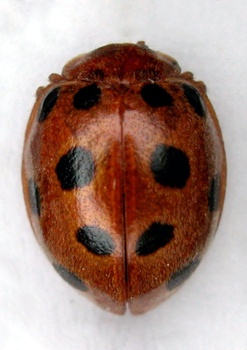Pests
Epilachna chrysomelina (Fabricius) - Melon Ladybird Beetle, Twelve-spotted Melon Beetle
Systematic position.
Class Insecta, order Coleoptera, family Coccinellidae, genus Epilachna Chevrolat.Biological group.
Pest of melons and gourds.Morphology and biology.
Body length, 7-9 mm. Body widely ovate, mainly red-brownish; metathorax black; dorsum covered with short hairs. Pronotum without spots; each elytra with 6 black points, of which posterior sometimes merged into V-bend. Shoulders widely rounded, tibiae simple. Epipleura is wide and flat. Egg the same as egg of Coccinella septempunctata, but not darkening before hatching. Larva in the 1st instar is about 2 mm in length, yellow; its dorsal surface is covered with 4 longitudinal rows of branched spicules. Mature larva is 9-10.5 mm in length, yellow-greenish, with 6 dorsal rows of spicules.Distribution.
Southern Europe, Africa, Asia Minor, Middle East, Afghanistan. In the former USSR it is known in the lowlands of Azerbaijan, in Turkmenistan, Uzbekistan, and Tajikistan southward of latitude 42°N.Ecology.
It gives 2-4 generations. Adults hibernate under the litter in fields or under rush, where sometimes hundreds of beetles per 1 plant are aggregated. Adults survive only a short time at temperature -14°C; therefore, population mortality during winter diapause sometimes amounts to 80%. Spring activity begins in middle or last thirds of April, after appearance of early melon or gourd seedlings. Diapause termination extends 15-20 days. Adults have diurnal activity and fly very well. Temperature of 27-32°C is optimum for the pest. Oviposition begins after a few days of additional feeding. Female lays eggs on the lower surface of host plant leaf. About 20-40 yellow eggs in one layer are inserted into an egg batch. Maximum rate of the oviposition occurs in the 2nd half of May. Fertility is about 150-300 eggs. The largest fertility is observed in the first generation, beetles of 3rd-4th generations don't lay eggs. Embryogenesis lasts 4-5 days. Larvae and adults gnaw parenchyma on the lower leaf surface and rind of young melon or cucumber. They feed on some weeds, too, including dandelion, goose-foot, and bindweed. Larva has 4 instars, developing 12-22 days. Pupation occurs on leaves and pupa develops 5-6 days. Hibernation begins in November, after average daily temperature lowers to 12-14°C. Unfertilized female hibernates.Economic significance.
The pest damages in adult and larval stages during all vegetation of host plants. It damages mainly melons, cucumbers, pumpkins, and vegetable marrows. Watermelon is damaged in a lesser degree. The pest sometimes entirely consumes seedlings of the melons and gourds of late sowings. Beetles are more gluttonous during reproduction time. Damaged melon and gourd fruits keep badly, decaying in 30-40 days. Control measures include removal of plant residues after harvesting, autumn plowing, and crop rotation. The literature reports about Epilachna chrysomelina harming activity on cotton are probably erroneous.Reference citations:
Ataeva M.A. 1972. Data on biology and ecology of Epilachna chrysomelina F. in Tadjikistan. Izvestiya AN Tadzhik. SSR 1(46): 85-86 (in Russian).Glushenkov N.A. 1951. Epilachna chrysomelina F. and its control. PhD Thesis. Leningrad: VIZR, 10 p. (in Russian).
Igamberdiev Kh. 1966. Epilachna chrysomelina F. and its control in Southern territories of Uzbekistan. In: Uspenskii F.M., ed. Proceedings of Middle Asia NIIZR. Tashkent: Uzbekistan, p. 87-92 (in Russian).
Igamberdiev Kh. 1967. Epilachna chrysomelina F. .pest of melons and gourds in the South of Uzbekistan. PhD Thesis. Tashkent: SKhI, 22 p. (in Russian).
Kryzhanovskii O.L. 1982. Family Coccinellidae. In: Kopaneva L.M., ed. Key to harmful and useful insects and mites of vegetable cultures and potato in the USSR. Leningrad: Kolos: 88-90 (in Russian).
Polyakov I.Ya., Kopaneva L.M. & Dorokhova G.I. 1982. Number of pests and entomophages of vegetable cultures and potato in different agricultural zones of the USSR. In: Kopaneva L.M., ed. Key to harmful and useful insects and mites of vegetable cultures and potato in the USSR. Leningrad: Kolos: 5-36 (in Russian).
Samedov N.G. 1963. Fauna and biology of the beetles injuring agricultural plants in Azerbaijan. Baku: AN Azerb. SSR. 384 p. (in Russian).
Tilavov T. 1985. Epilachna chrysomelina F. Plant protection (4): 38-39 (in Russian).
Vinogradova V.N. 1950. About biology of Epilachna chrysomelina F. Reports of the Tadjikistan branch of AS USSR (29): 29-31 (in Russian).


